Page 130 of 726
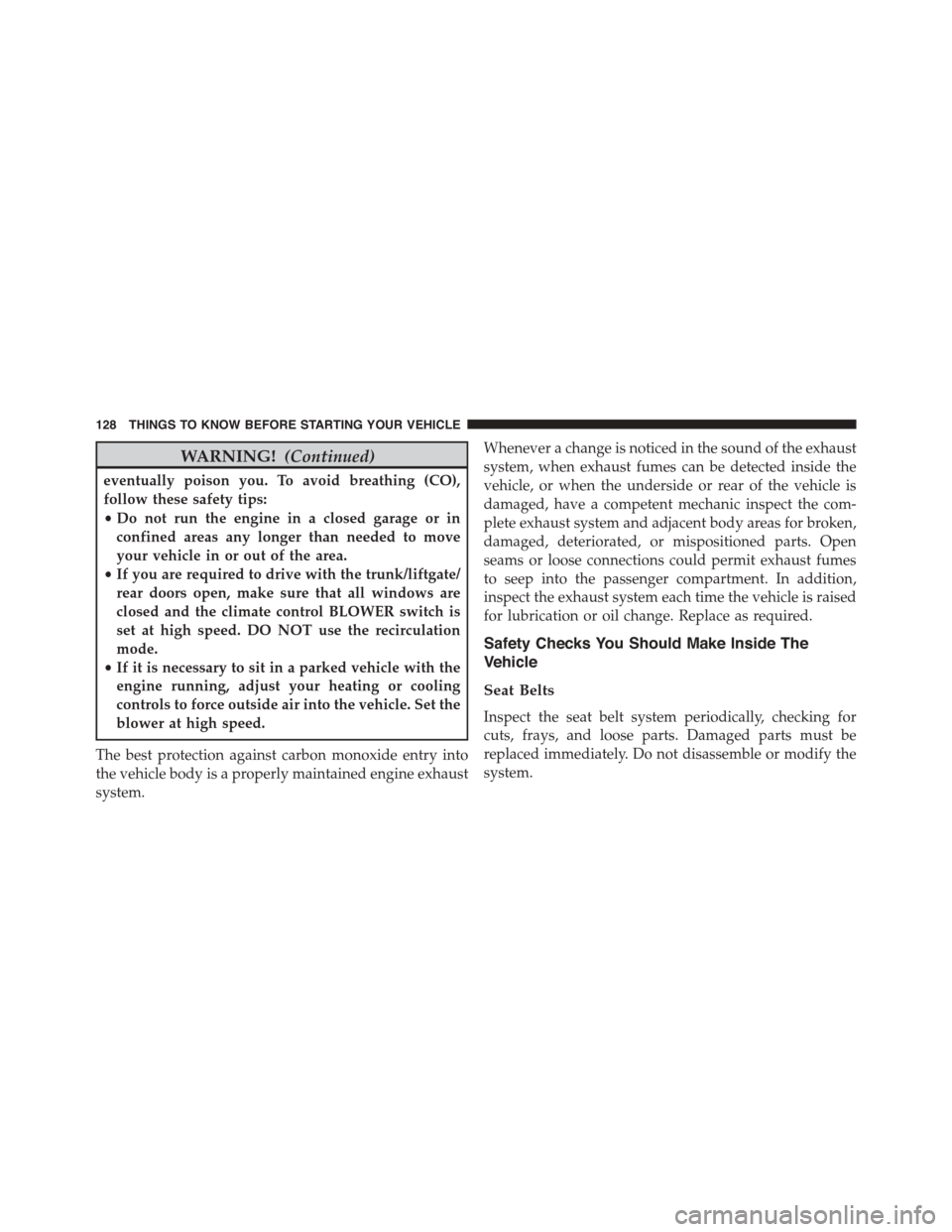
WARNING!(Continued)
eventually poison you. To avoid breathing (CO),
follow these safety tips:
•Do not run the engine in a closed garage or in
confined areas any longer than needed to move
your vehicle in or out of the area.
•If you are required to drive with the trunk/liftgate/
rear doors open, make sure that all windows are
closed and the climate control BLOWER switch is
set at high speed. DO NOT use the recirculation
mode.
•If it is necessary to sit in a parked vehicle with the
engine running, adjust your heating or cooling
controls to force outside air into the vehicle. Set the
blower at high speed.
The best protection against carbon monoxide entry into
the vehicle body is a properly maintained engine exhaust
system.
Whenever a change is noticed in the sound of the exhaust
system, when exhaust fumes can be detected inside the
vehicle, or when the underside or rear of the vehicle is
damaged, have a competent mechanic inspect the com-
plete exhaust system and adjacent body areas for broken,
damaged, deteriorated, or mispositioned parts. Open
seams or loose connections could permit exhaust fumes
to seep into the passenger compartment. In addition,
inspect the exhaust system each time the vehicle is raised
for lubrication or oil change. Replace as required.
Safety Checks You Should Make Inside The
Vehicle
Seat Belts
Inspect the seat belt system periodically, checking for
cuts, frays, and loose parts. Damaged parts must be
replaced immediately. Do not disassemble or modify the
system.
128 THINGS TO KNOW BEFORE STARTING YOUR VEHICLE
Page 634 of 726
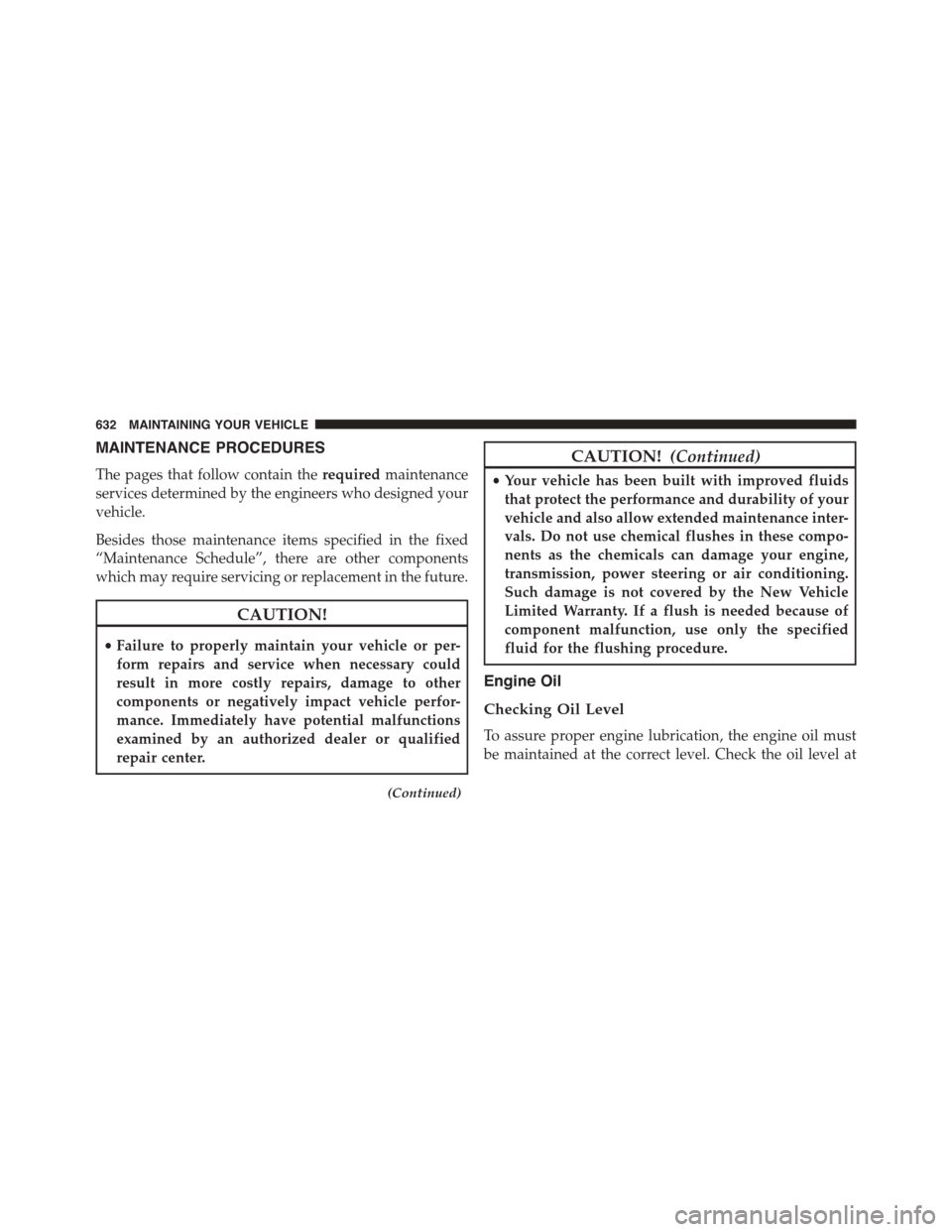
MAINTENANCE PROCEDURES
The pages that follow contain therequiredmaintenance
services determined by the engineers who designed your
vehicle.
Besides those maintenance items specified in the fixed
“Maintenance Schedule”, there are other components
which may require servicing or replacement in the future.
CAUTION!
•Failure to properly maintain your vehicle or per-
form repairs and service when necessary could
result in more costly repairs, damage to other
components or negatively impact vehicle perfor-
mance. Immediately have potential malfunctions
examined by an authorized dealer or qualified
repair center.
(Continued)
CAUTION!(Continued)
•Your vehicle has been built with improved fluids
that protect the performance and durability of your
vehicle and also allow extended maintenance inter-
vals. Do not use chemical flushes in these compo-
nents as the chemicals can damage your engine,
transmission, power steering or air conditioning.
Such damage is not covered by the New Vehicle
Limited Warranty. If a flush is needed because of
component malfunction, use only the specified
fluid for the flushing procedure.
Engine Oil
Checking Oil Level
To assure proper engine lubrication, the engine oil must
be maintained at the correct level. Check the oil level at
632 MAINTAINING YOUR VEHICLE
Page 635 of 726
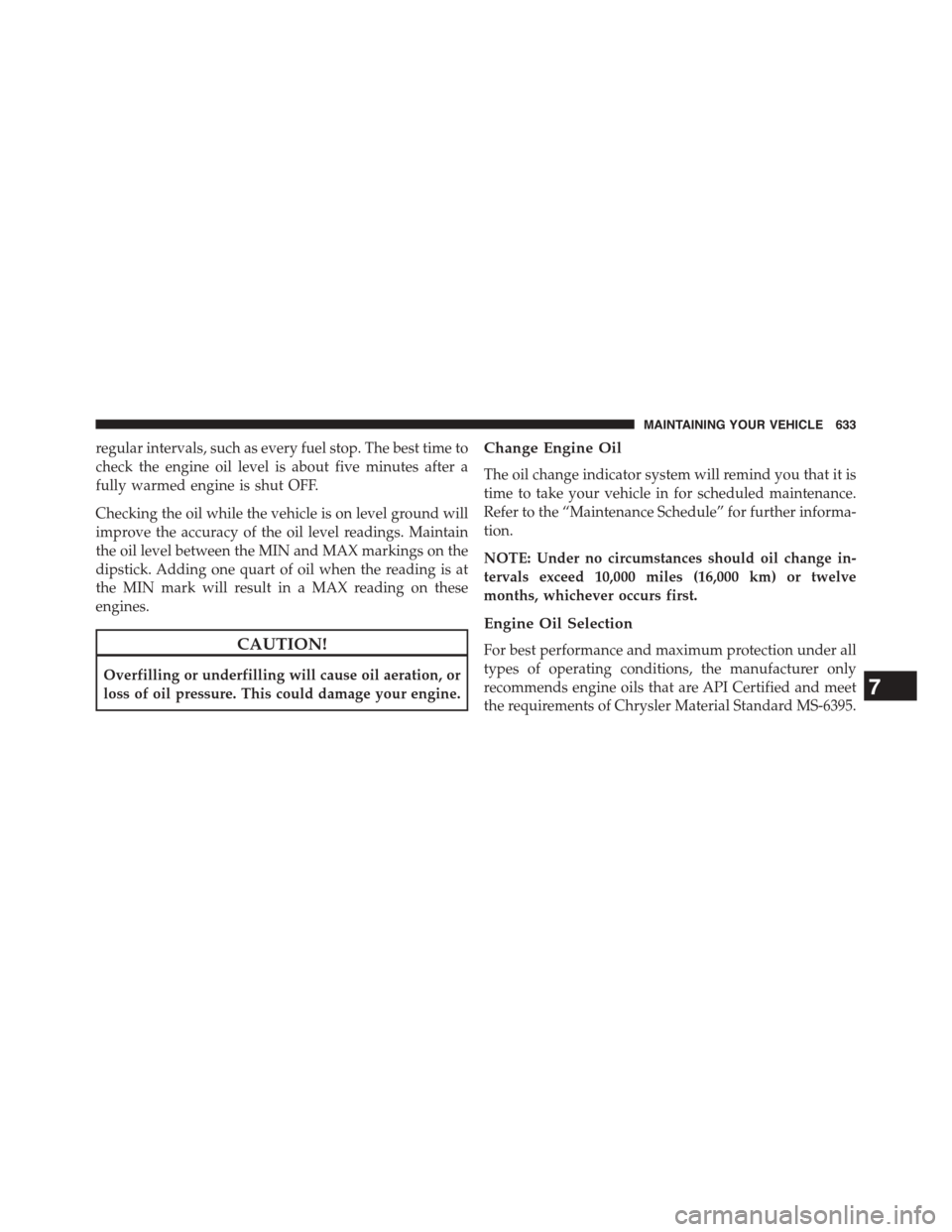
regular intervals, such as every fuel stop. The best time to
check the engine oil level is about five minutes after a
fully warmed engine is shut OFF.
Checking the oil while the vehicle is on level ground will
improve the accuracy of the oil level readings. Maintain
the oil level between the MIN and MAX markings on the
dipstick. Adding one quart of oil when the reading is at
the MIN mark will result in a MAX reading on these
engines.
CAUTION!
Overfilling or underfilling will cause oil aeration, or
loss of oil pressure. This could damage your engine.
Change Engine Oil
The oil change indicator system will remind you that it is
time to take your vehicle in for scheduled maintenance.
Refer to the “Maintenance Schedule” for further informa-
tion.
NOTE: Under no circumstances should oil change in-
tervals exceed 10,000 miles (16,000 km) or twelve
months, whichever occurs first.
Engine Oil Selection
For best performance and maximum protection under all
types of operating conditions, the manufacturer only
recommends engine oils that are API Certified and meet
the requirements of Chrysler Material Standard MS-6395.
7
MAINTAINING YOUR VEHICLE 633
Page 709 of 726
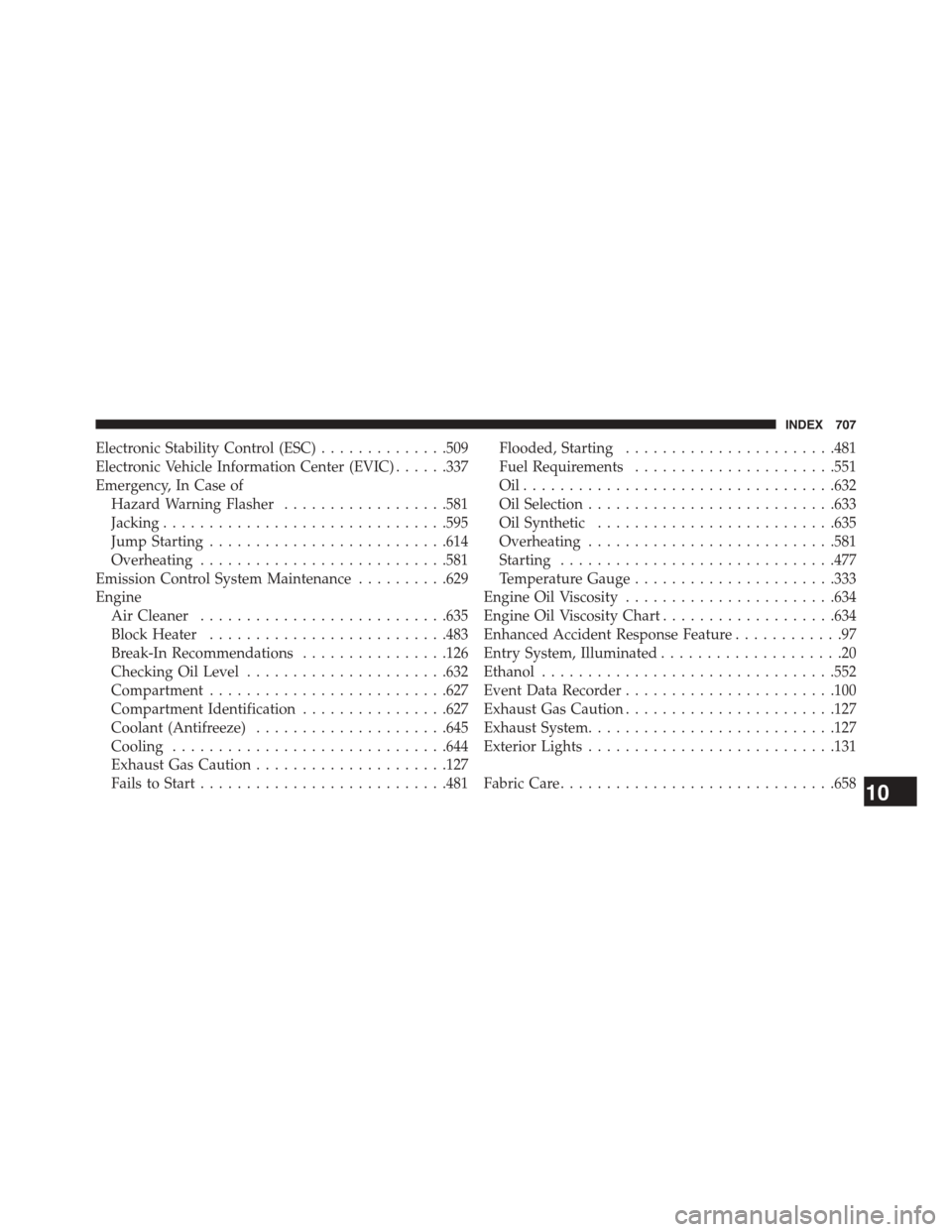
Electronic Stability Control (ESC)..............509
Electronic Vehicle Information Center (EVIC)......337
Emergency, In Case of
Hazard Warning Flasher..................581
Jacking...............................595
Jump Starting..........................614
Overheating...........................581
Emission Control System Maintenance..........629
Engine
Air Cleaner...........................635
Block Heater..........................483
Break-In Recommendations................126
Checking Oil Level......................632
Compartment..........................627
Compartment Identification................627
Coolant (Antifreeze).....................645
Cooling..............................644
Exhaust Gas Caution.....................127
Fails to Start...........................481
Flooded, Starting.......................481
Fuel Requirements......................551
Oil . . . . . . . . . . . . . . . . . . . . . . . . . . . . . . . . ..632
Oil Selection...........................633
Oil Synthetic..........................635
Overheating...........................581
Starting..............................477
Temperature Gauge......................333
Engine Oil Viscosity.......................634
Engine Oil Viscosity Chart...................634
Enhanced Accident Response Feature............97
Entry System, Illuminated....................20
Ethanol................................552
Event Data Recorder.......................100
Exhaust Gas Caution.......................127
Exhaust System...........................127
Exterior Lights...........................131
Fabric Care..............................65810
INDEX 707
Page 716 of 726
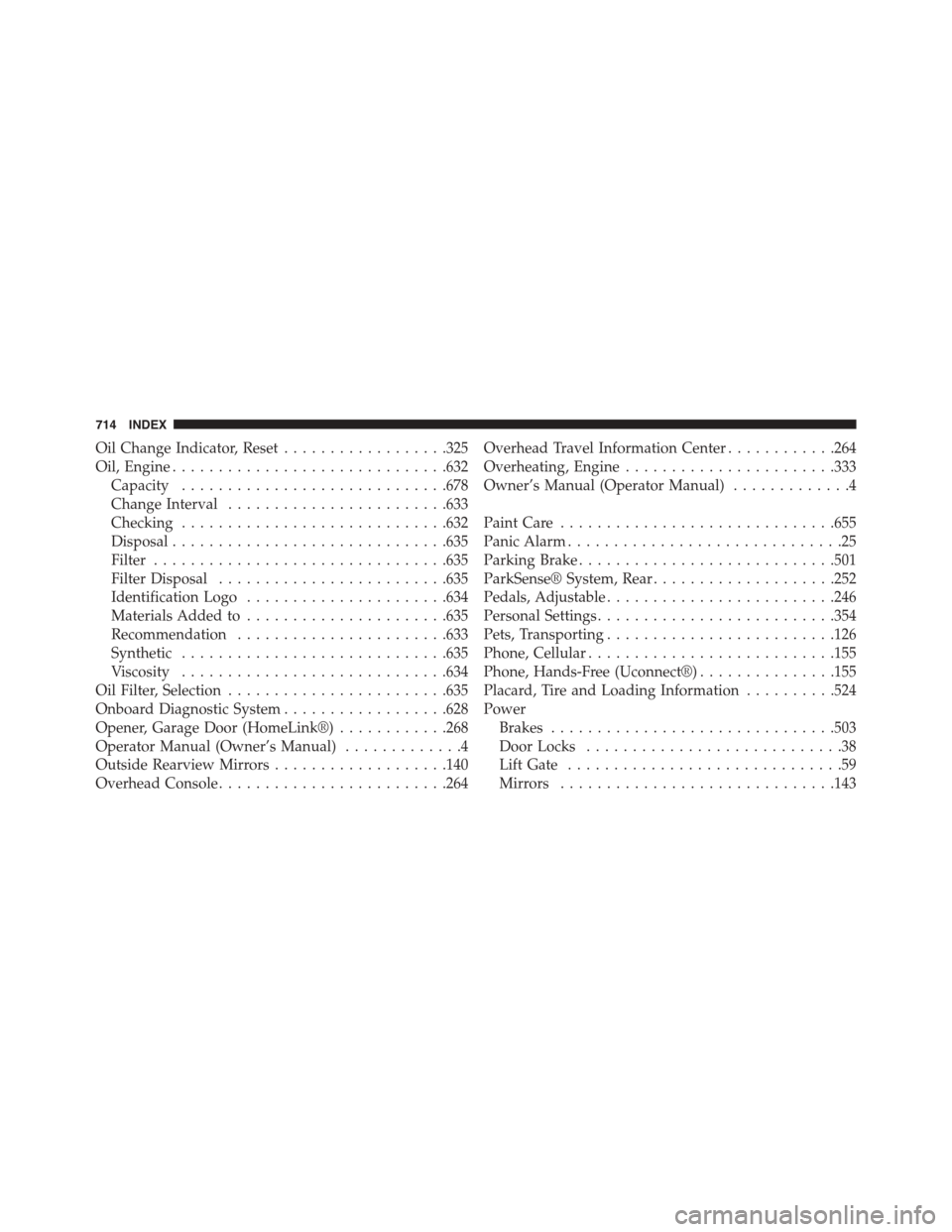
Oil Change Indicator, Reset..................325
Oil, Engine..............................632
Capacity.............................678
Change Interval........................633
Checking.............................632
Disposal..............................635
Filter................................635
Filter Disposal.........................635
Identification Logo......................634
Materials Added to......................635
Recommendation.......................633
Synthetic.............................635
Viscosity.............................634
Oil Filter, Selection........................635
Onboard Diagnostic System..................628
Opener, Garage Door (HomeLink®)............268
Operator Manual (Owner’s Manual).............4
Outside Rearview Mirrors...................140
Overhead Console.........................264
Overhead Travel Information Center............264
Overheating, Engine.......................333
Owner’s Manual (Operator Manual).............4
Paint Care..............................655
Panic Alarm..............................25
Parking Brake............................501
ParkSense® System, Rear....................252
Pedals, Adjustable.........................246
Personal Settings..........................354
Pets, Transporting.........................126
Phone, Cellular...........................155
Phone, Hands-Free (Uconnect®)...............155
Placard, Tire and Loading Information..........524
Power
Brakes...............................503
Door Locks............................38
Lift Gate..............................59
Mirrors..............................143
714 INDEX